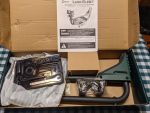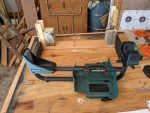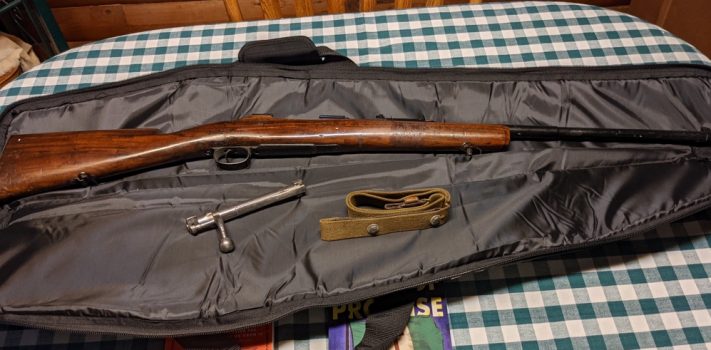A couple of years ago, I submitted an article to SurvivalBlog for the non-fiction writing contest. I wrote the article because I had a story to tell. I thought that SurvivalBlog readers might find it interesting or entertaining. I had so much fun writing that first article, that I just kept on writing more. Over the course of the following months I submitted a half dozen or so additional articles. Then, in June of 2020, something wonderful happened: I won third place in the writing contest. Among other great prizes was a transferable $100 purchase credit from Elk Creek Company. The credit was good toward the purchase of any pre-1899 antique gun. I was pretty excited. I was not quite ready to make a purchase, but I checked Elk Creek inventory regularly to keep track of what was available.
The Covid gun-buying panic made things discouraging for a while. The antiques I was most interested in were snapped up quickly, and most of the ones that remained were priced beyond my reach.
I continued to write regularly for SurvivalBlog. I was having so much fun writing that I just could not stop. There were all kinds of interesting things I wanted to try out and then write about.
In the course of the following months, I won honorable mention in the writing contest a number of times. At first, the prize for honorable mention was an Amazon gift card. After Amazon got involved in dirty political tricks, the prize for honorable mention became a purchase credit from Elk Creek Company. In February of 2021, I won a $50 purchase credit. Then in April and June, I won additional $100 purchase credits. Suddenly I was starting to accumulate some substantial purchasing power.
About that same time, the worst of the Covid gun-buying panic began to recede. Inventory at Elk Creek Company began to grow and to include more options in the price range in which I was most interested. First, I noticed a dandy Brazilian M1894 short rifle converted to 6.5x55mm Mauser for about $650. Then a couple of Chilean Contract Loewe Mauser M1895 short rifles came into stock at about $450 dollars each. And finally, a nice sporterized Oviedo Mauser M1893 short rifle was also added, for about $450. The combination of historic interest, less restrictive regulations, and practical usefulness made pre-1899 shooting grade cartridge gun antiques particularly attractive to me.
Finally, in August of 2021, I won another $100 purchase credit, for a total of $450 in purchase credits. I was at the point where I could make a purchase, and pay the bulk of the price with purchase credits.
I decided to go with the sporterized Oviedo M1893 Mauser. The original sights on M1895 rifles were set to a minimum of 300 meters. I was hoping that the sporterized sights on the M1893 would allow me to zero for 100 yards.
When I placed my order with Elk Creek Company, I was expecting to pay extra for shipping and insurance. JWR generously covered these additional expenses as well. I greatly appreciate his kindness.
Pre-1899 Antique Guns
As JWR notes in his excellent post, The Pre-1899 Antique Gun FAQ, “any firearm with a frame or receiver that [was] actually made before Jan. 1, 1899 is legally ‘antique’ and not considered a ‘firearm’ under Federal law.” Although State and local laws may vary, “No FFL is required to buy or sell antiques across state lines.” Thus they are legally able to be shipped by the US Postal Service across state lines directly to your doorstep.
A Historically Significant Rifle
I was especially interested in an M1893 Spanish Mauser because of its significant historical interest and influence.
On July 1, 1889, American forces, including Teddy Roosevelt and his Rough Riders, captured the San Juan Heights from Spanish forces in the bloodiest and most famous battle of the Spanish-American War.
The American force outnumbered the Spanish defenders by 16 to 1, but took heavier casualties. This was largely due to the M1893 Mausers with which the Spanish were armed. The Mauser was superior to the Krag-Jørgensen and Trapdoor Springfield rifles with which the Americans were armed in terms of range, accuracy, and sustained rate of fire. The range of the Mauser was greater, because its stronger action (with two locking lugs on the bolt in contrast to the one on the Krag-Jørgensen) allowed it to fire a more powerful cartridge. The Mauser was more accurate due to the greater sectional density of its 7 mm bullet. And the Mauser had a higher sustained rate of fire because it could be reloaded with stripper clips, in contrast to the Krag-Jørgensen, which needed to have its magazine reloaded one round at a time.
The American experience at San Juan Hill was a major factor leading to the abandonment of the Krag-Jørgensen rifle and the development of the 1903 Springfield rifle by the US Army. Many features of the 1903 Springfield were inspired by the M1893 Mauser. In fact, the US lost a patent infringement suit to Mauser for their M1893 and M1898 designs, and had to pay a royalty for each M1903 manufactured and Mauser-type stripper clip manufactured.
Meanwhile, Boer militia armed with the M1895 Mauser (which is very similar to the M1893 and which is also chambered for the 7×57 mm cartridge) were making life difficult for the British Empire in South Africa in the Second Boer War. Like the Krag-Jørgensen, the British Lee-Metford came up wanting in comparison with the Mauser. This trial by battle accelerated the transition from the Lee-Metford to the Lee-Enfield, which had a barrel that was better adapted to the use of smokeless powder cartridges.
The relatively flat trajectory and low recoil of the 7×57 round also made it popular with hunters. More than 100 years later, it is still considered to be a very useful cartridge, suitable for taking deer-sized game out to about 300 yards.
Ammo
The ongoing ammo shortage made it difficult to find any food for my “new” M1893. I first checked out local retailers without success. Next, I checked my favorite online retailers, with similar results. Finally, I placed an order on Gunbroker.com with Jestice Arms of Kingsport, Tennessee. I ordered 100 rounds of new Sellier and Bellot 140 grain FMJ 7×57 ammo. Less than a week later, my new ammo arrived in good condition.
Seeking a Lead Sled
I was not enthusiastic about the idea of having my face near the action of a 123 year-old rifle the first time it was test fired. I decided to use a string to pull the trigger while I was safely sheltered behind a nearby wood stack.
I learned many things by watching Road Runner cartoons on Saturday mornings while I was growing up. I particularly remember one episode in which Wile E Coyote attached strings to the triggers of a battery of firearms, and discharged them by pulling the strings, (“Zipping Along”, starting at about 4:42 into the episode). His experience illustrated that pulling a string attached to the trigger of a poorly anchored firearm could move the point of aim at discharge in an undesirable direction. With this in mind, I contacted Caldwell, and asked if I could borrow a Lead Sled/rifle rest for my testing.
When an answer from Caldwell was not immediately forthcoming, I designed and built a lead sled equivalent using scrap lumber and the mechanism from a broken screw jack. The day after my homemade lead sled was complete, I received a very kind message from Caldwell informing me that they were sending me their Lead Sled 3 and a weight bag. I was delighted.
Mr. Postman
The rifle shipped on a Wednesday, and the USPS tracking information stated that it was expected to arrive by the following Wednesday. When the package took several days to arrive at the USPS regional center nearest the point of shipment, and then languished at that regional center for several more days, I began to suspect that “Ol’ Escargot” had overpromised and would underdeliver. This proved to be the case. The package cut a torturous, zig-zag path across the continent, going west to go east and then too far east before heading west again. It was finally delivered five days later than originally projected.
Opening the Box
The rifle arrived in a 53″x8″x4.5″ box with a shipping weight of 12 lbs., 13.8 oz. I opened the box to discover that the rifle had shipped in a nice gun case along with two surprise bonus items: the books Tools for Survival and Land of Promise, both by JWR, and both autographed by him. I knew from past reading that the first book is outstanding, and I am enjoying reading the second.
The rifle case is a brand new one from kylebooker.com. The rifle was nicely packaged and padded within the case with outstanding attention to detail. For example, the rear sling swivel was carefully encased in bubble wrap to prevent it from scratching the stock in transit.
Removing the packaging material revealed a venerable rifle that was amazingly advanced for its time. It is easy to see why the Mauser has been so widely copied by other manufacturers over the years. This particular example shows evidence of being often carried but seldom fired, and still appeared to be in flawless working order.
I was surprised by how good the trigger functioned for a 123-year-old rifle, by how well the rifle balances, by the density of the wood in the stock, and by the craftsmanship of the metal. The safety was difficult to move at first, suggesting that I should disassemble and clean the bolt before winter, but the bolt cocked easily on closing, and the rifle dry-fired well.
The rifle has a 22″ barrel, and is 42″ overall, which is a very convenient size.
I decided that a good cleaning and inspection would be a wise first step toward becoming familiar with the rifle. The first half dozen or so cleaning patches through the bore came out greenish, suggesting some copper fouling. The rifling looked good, and I could not detect any pitting in the bore.
There seemed to be small traces of cosmoline or some other tarry substance on the outside of the bolt. I was able to remove most of it through an extended application of elbow grease. I anticipate that future cleanings will result in further progress.
The sporterized stock has received much hard use over the years, with many blemishes, but it is still structurally sound. I would not consider refinishing the stock of any pre-1899 gun that is in original condition, since that would deface a historic artifact. Since this particular rifle has already been sporterized, I hope to refinish the stock eventually to improve its appearance.
After a thorough cleaning, the old girl seemed happier and more content. I certainly was.
The Caldwell Lead Sled 3
 FedEx decided to take a page from the US Postal Service’s book, and was also several days late delivering the lead sled. The 38″x12″x9″ box looked a little battered in transport, with the flaps on one end pushed in. But when I cut the tape, I found the inner boxes containing the Lead Sled 3 and the Large Lead Sled Weight Bag to be undamaged. The packing list indicated that the lead sled weighed 16.1 lbs. and the weight bag .5 lbs. The boxes indicated that both items are, unfortunately, made in China.
FedEx decided to take a page from the US Postal Service’s book, and was also several days late delivering the lead sled. The 38″x12″x9″ box looked a little battered in transport, with the flaps on one end pushed in. But when I cut the tape, I found the inner boxes containing the Lead Sled 3 and the Large Lead Sled Weight Bag to be undamaged. The packing list indicated that the lead sled weighed 16.1 lbs. and the weight bag .5 lbs. The boxes indicated that both items are, unfortunately, made in China.
The lead sled is designed to hold up to 50 lbs. of barbell weights or up to 100 lbs. of lead shot. The large weight bag is designed to hold approximately 20 lbs. of sand.
As I opened the lead sled box, the directions noted some “Important Safety Information.” This information included the advice, “Always hold the forend of the firearm when shooting off of this shooting rest. If it is not held, the recoil can cause the forend to jump out of the [sled] possibly causing damage to the firearm or injuring the shooter.” Since I was not, in fact, planning to hold the forend of the rifle the first time I shot it, I made a mental note to somehow secure it to the front of the sled.
The manual seemed to reflect some evidence of poorly edited cutting and pasting from the manuals of other systems (for example, inconsistency in referring to the name of the product). But the essentials seemed to be accurate, producing a fairly straightforward and clear set of directions.
The next day I brought the box with the lead sled out to the barn for assembly. I laid all the parts out on my work surface, and compared them with the parts list. All seemed to be present and accounted for.
The directions were clear, all of the tools necessary for assembly were supplied. The product seemed to be well-engineered and skillfully machined, with all of the parts fitting smoothly together. With my ten thumbs, I managed to drop a part or two, but found them again quickly with minimal searching.
 When the lead sled was completely assembled, I opened the box with the weight bag. There were no directions provided beyond the information printed on the outside of the box, but preparation was straightforward and intuitive. There was a velcro divider in the middle of the bag separating it into two compartments. It was a simple matter of zipping open the bag, fastening the velcro, shoveling in sand, and zipping the bag closed.
When the lead sled was completely assembled, I opened the box with the weight bag. There were no directions provided beyond the information printed on the outside of the box, but preparation was straightforward and intuitive. There was a velcro divider in the middle of the bag separating it into two compartments. It was a simple matter of zipping open the bag, fastening the velcro, shoveling in sand, and zipping the bag closed.
It was virtually impossible not to get some sand on the zipper while filling the bag, and this made it somewhat difficult to get the zipper to close again after the bag was full. After a little brushing and blowing, both ends of the zipper started to move, and closed the bag securely.
(To be concluded tomorrow, in Part 2.)










